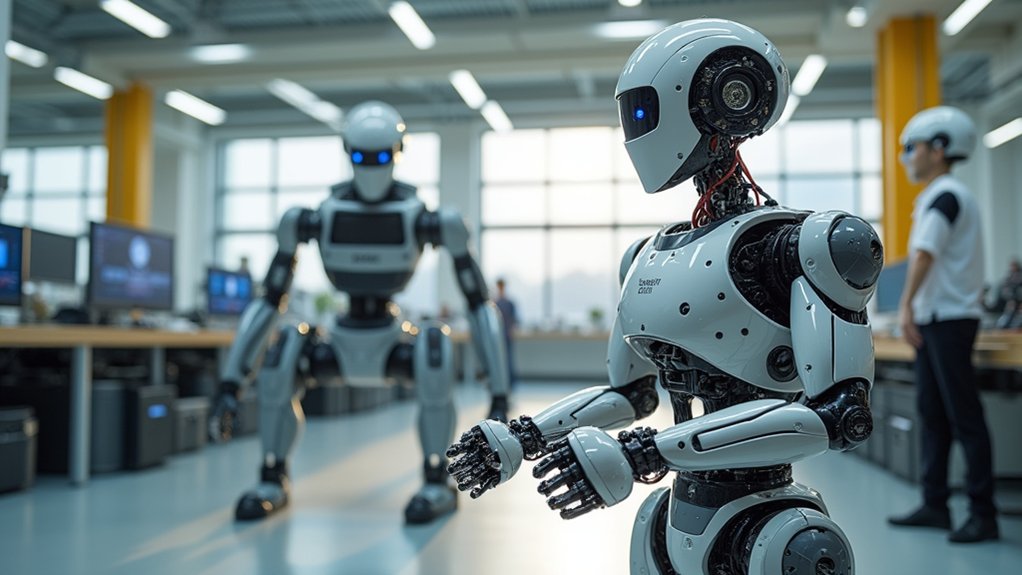What technologies does Boston Dynamics use for humanoids?
Boston Dynamics is renowned for its cutting-edge humanoid robots, and if you’re wondering what technologies they use, you’re in the right place. These advanced machines combine state-of-the-art technologies to replicate human-like agility and awareness. Key components like powerful actuators, smart sensors, and advanced control systems work together seamlessly to enhance the robots’ movement and adaptability. But there’s more to these humanoid robots than just hardware. A sophisticated layer of artificial intelligence drives their actions, making them truly remarkable. If you’re interested in technology, apps, smartphones, and software, understanding the innovations behind Boston Dynamics‘ humanoid robots will surely captivate your attention.

Advanced actuation and mobility systems
When it comes to cutting-edge technology, Boston Dynamics stands out with its advanced actuation and mobility systems. These innovative systems enable humanoid robots to navigate real-world environments with ease.
Featuring powerful electric motors and hydraulic actuators, these robots mimic human-like movements, making it possible for them to maintain balance and adapt to uneven terrains. They can even recover from disturbances seamlessly.
By precisely controlling each joint, these advanced actuation and mobility systems allow robots to jump, run, lift, and climb with remarkable efficiency.
If you’re interested in robotics, understanding the power of advanced actuation and mobility systems is essential.
Perception and sensor integration
Boston Dynamics’ humanoid robots are at the forefront of technology, utilizing advanced perception systems and integrated sensors to interact safely and effectively with their surroundings.
These robots are equipped with cameras, LiDAR, and depth sensors that work together seamlessly. This combination allows for precise environmental mapping and obstacle detection, crucial for navigation and object manipulation.
The state-of-the-art sensors enable the robots to identify objects, track motion, and gauge distances, ensuring they’ve accurate situational awareness. This is essential for safe human-robot interaction, especially in complex and dynamic environments.
Real-time control algorithms
These advanced algorithms are key to the robots’ ability to process detailed environmental data from robust perception and sensor integration. By calculating precise motor commands in real-time, these control algorithms ensure smooth movement and quick adaptation to any changes in the surroundings.
With the help of these real-time control algorithms, the robots maintain balance, coordinate their limbs, and effectively recover from disturbances. This enables them to perform dynamic tasks safely and efficiently, even on unpredictable terrain.
Real-time control algorithms are truly revolutionizing how robots interact with their environment.
Artificial intelligence and machine learning
Within the realm of robotics, Boston Dynamics stands out by integrating artificial intelligence and machine learning into their cutting-edge creations.
These technologies are at the core of the robots’ ability to understand and adapt to complex environments. With the power of artificial intelligence, Boston Dynamics’ robots can recognize obstacles, plan effective movements, and seamlessly adjust their behaviors in real-time.
Machine learning further enhances these capabilities by allowing robots to analyze sensor data, which improves their balance and coordination. This enables the robots to navigate unpredictable scenarios and complete tasks autonomously, without the need for direct human intervention.
Mechanical design and material engineering
When it comes to cutting-edge technology and robotics, Boston Dynamics is a true pioneer. Their humanoid robots stand out due to their agility and resilience, thanks to innovative mechanical design and advanced material engineering.
These robots feature robust actuators and lightweight alloys that ensure lifelike motion without compromising strength. The use of composite materials allows for precision-crafted joints and optimized weight distribution, enabling the robots to balance, jump, and recover from falls with ease.
Each component is meticulously engineered for durability and efficiency, ensuring seamless integration with the control systems. In the world of technology, where apps, smartphones, and software advancements are key, Boston Dynamics continues to lead the way with their remarkable mechanical design and material engineering solutions.
Conclusion
Boston Dynamics’ humanoid robots are a technological marvel, showcasing a blend of advanced technologies that make them truly unique. These robots are equipped with powerful motors and smart sensors, allowing them to tackle real-world challenges with ease. The use of real-time control and adaptive AI ensures that Boston Dynamics’ humanoid robots can navigate complex environments efficiently. Lightweight materials and ingenious engineering contribute to their agility and robustness.
By integrating these cutting-edge systems, Boston Dynamics ensures that their humanoid robots do more than just move—they navigate, perceive, and adapt like the futuristic machines they are designed to be. Whether it’s in technology, apps, smartphones, or software, Boston Dynamics’ humanoid robots are setting the standard for innovation and excellence.